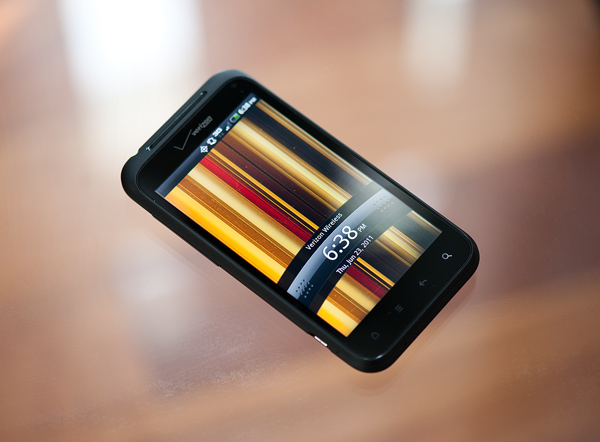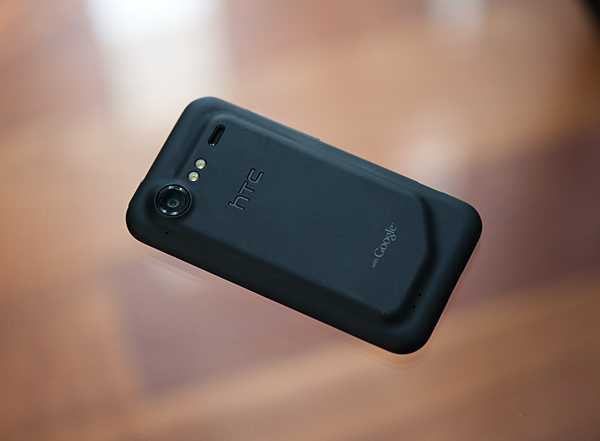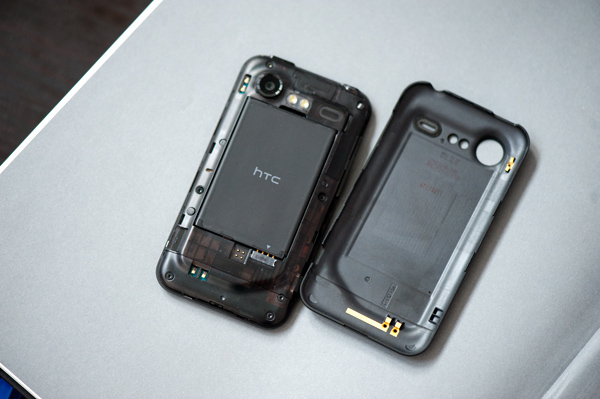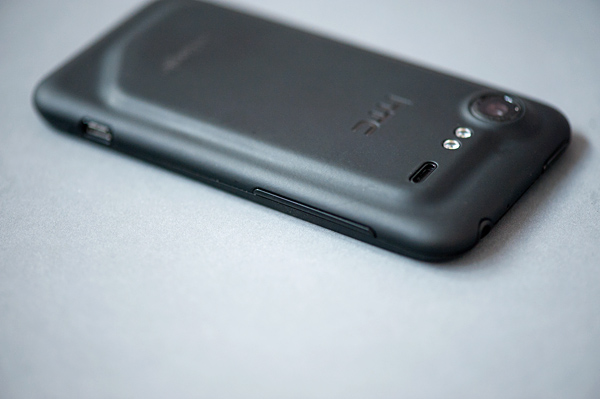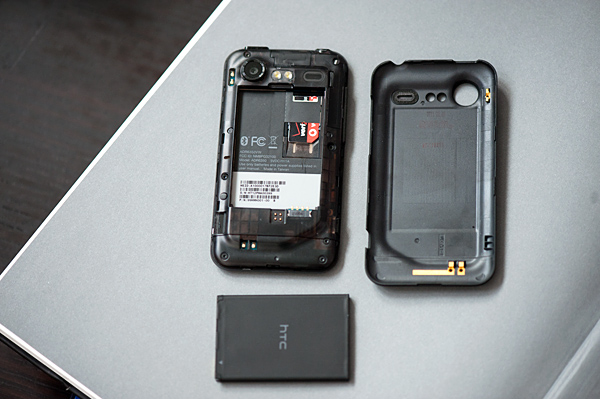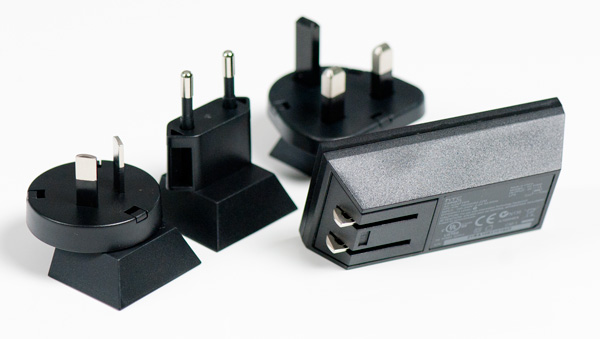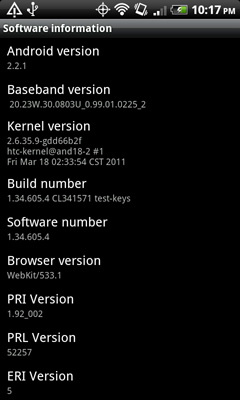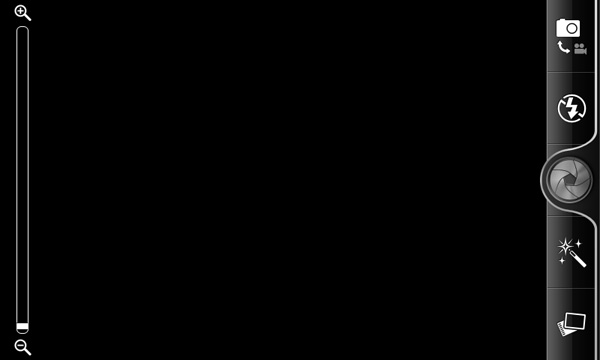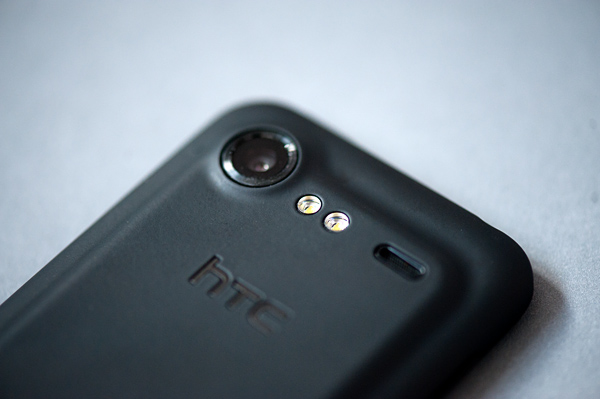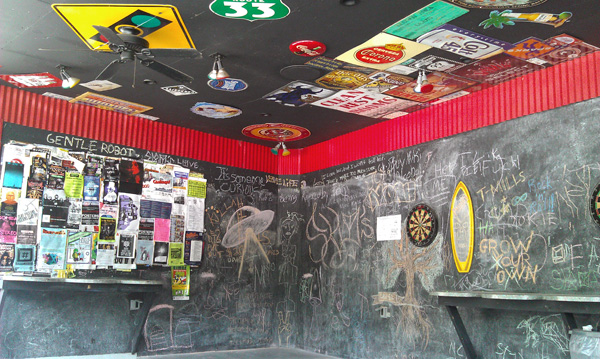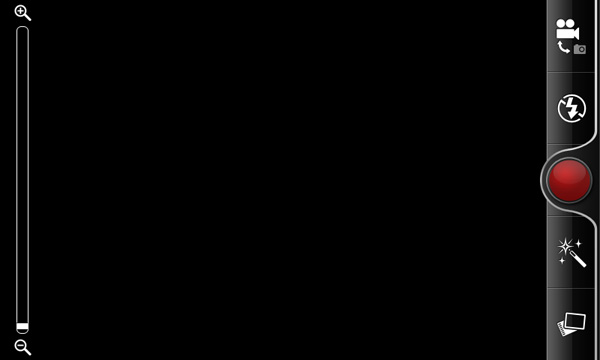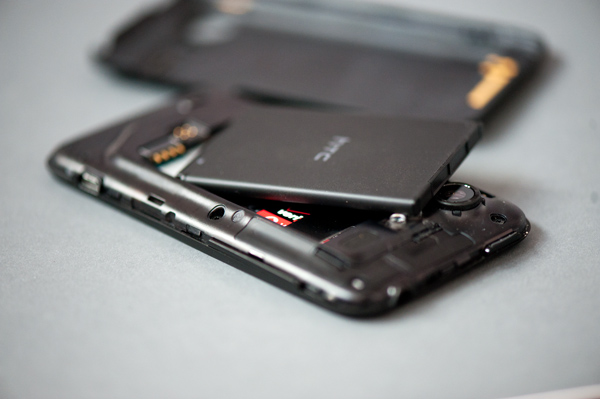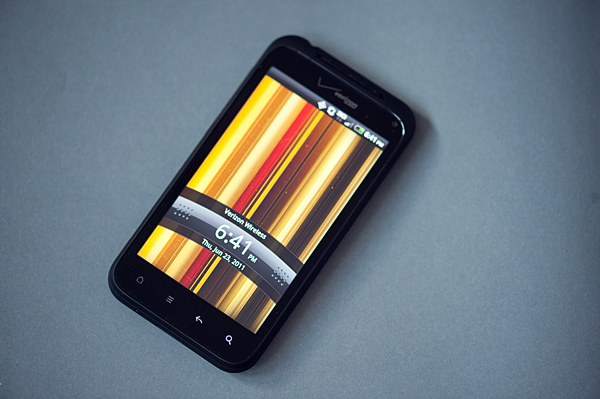
Original Link: https://www.anandtech.com/show/4484/htc-droid-incredible-2-review
HTC Droid Incredible 2 Review
by Anand Lal Shimpi on July 3, 2011 11:44 PM EST- Posted in
- HTC
- Verizon
- Smartphones
- Droid Incredible 2
- Mobile
The original Droid Incredible by HTC was the second Android phone I ever officially reviewed. The first was Google's Nexus One. A year ago I proudly proclaimed that the Incredible was clearly better than the Nexus One thanks to the added features HTC delivered through Sense. Since then we've seen Google improve Android tremendously. The OS has come so far in the past twelve months that I do wish more vendors would actually ship unaltered versions of it on their devices. HTC has kept up with Google's evolution, at least on some of their devices. The Sensation 4G, EVO 3D and Flyer all ship with a brand new version of the Sense UI (3.0) that actually adds some pretty neat features to the OS (e.g. the ability to launch apps from the lock screen).
Unfortunately the successor to the original Incredible isn't blessed with Sense 3.0, it's still running version 2.0. The Incredible 2 also doesn't ship with Gingerbread, it's currently only available with Android 2.2.1. Qualcomm does have a working Gingerbread port, something HTC is quite familiar with as all of the devices I mentioned above ship with Gingerbread. The Incredible 2 is due for an update to Gingerbread soon but if you buy it today all you get is Froyo.
The seemingly dated software comes with similarly dated hardware, at least by today's standards. The Incredible 2 ships with Qualcomm's MSM8655 SoC. That's a 45nm SoC with a single-core 1GHz Snapdragon and an Adreno 205 GPU. The chip has 768MB of memory on package. CPU performance isn't improved compared to the original Incredible although the GPU is faster and power consumption is lower thanks to the 45nm process (the original Incredible had a 65nm QSD8650 with an Adreno 200).
While this is an upgrade from the original Incredible, HTC's high end phones these days ship with MSM8660 SoCs: the dual-core, Adreno 220 packing successor to the 8655. In a world where the past six months have been dominated by talk of NVIDIA's dual-core Tegra 2, shipping a high end single-core phone seems silly.
The Incredible 2 increases screen size over the original to a comfortable 4-inches. HTC went with a Super LCD display (PVA) with an 800 x 480 resolution. With Android I firmly believe that the 4-inch screen is ideal for the platform. Anything smaller and it's too difficult to type on. Anything larger and it's not as comfortable to carry around with you.
In your hand the Incredible 2 feels good but not perfect. It's a few mm too wide in my opinion. The front is all glass save for a thin bezel around the sides. The bezel is raised so you can lay the phone flat without worrying about scratching the glass. The four Android buttons are capacitive touch and backlit. The Android buttons will also rotate orientation if you hold the Incredible 2 in landscape vs. portrait. They'll always be in the same place but they'll simply rotate 90 degrees so they're always facing up. Like we saw on the Flyer this button rotation only works if you hold the phone in portrait mode with the Verizon logo facing up or rotate it 90 degrees counter clockwise so the buttons are to the right of you.
Anything that isn't glass is made of soft touch plastic. Despite having a removable back the device feels solid and didn't exhibit any squeaks or creaks when handled. My only concern about soft touch plastic like this is it tends to age really poorly and develop shiny splotches as it accumulates oils from your skin and some of the finish wears off.
The power/lock button is up top and the volume rocker is on the left side. There's also a micro USB port on the left side for charge/sync - there is no HDMI output on the Incredible 2.
Around back is an 8MP camera sensor with dual LED flash. The speakerphone grill is to the right of the rear camera. There's a 1.3MP front facing camera as well.
The back cover pulls off with the uncomfortable release of a few clips around the edge. I'm always afraid I'm going to break something whenever I pull off these HTC covers. Underneath the cover is the Incredible 2's 5.36Whr battery, an upgrade from its predecessor.
Go down one more level and you'll find a SIM card slot behind the battery. The Incredible 2 is a world phone that supports 800/1900MHz CDMA networks, 900/2100MHz UMTS/HSPA+ and 850/900/1800/1900MHz GSM/GPRS/EDGE networks. I traveled to both Abu Dhabi and Taiwan with the Incredible 2, unfortunately I didn't tell Verizon beforehand and thus didn't have service in either location. As a world phone you do get a number of additional plugs for the power adapter:
Keeping with recent HTC tradition, the back cover actually houses the cellular, Bluetooth and WiFi antennas. Remove the cover and you quickly lose all cellular reception on the Incredible 2. In the US, EVDO is the fastest cellular network supported - there's no WiMAX or LTE here. The Incredible 2 supports 802.11b/g/n.
The microSD card slot is accessible without removing the battery but you still need to take off the case to get to it. Verizon sells the Incredible 2 under contract (2-year agreement) for $199 with a 16GB microSD card.
| Physical Comparison | |||||||
| Apple iPhone 4 | HTC Thunderbolt | Motorola Droid X2 | HTC Droid Incredible | HTC Droid Incredible 2 | |||
| Height | 115.2 mm (4.5") | 122 mm (4.8") | 126.5 mm (4.98") | 117.5 mm (4.63") | 126.3 mm (4.97") | ||
| Width | 58.6 mm (2.31") | 67 mm (2.63") | 65.5 mm (2.58") | 58.5 mm (2.30") | 65.5 mm (2.58") | ||
| Depth | 9.3 mm ( 0.37") | 13.2 mm (0.52") | 9.9 mm (0.39") | 11.9 mm (0.47") | 11.6 mm (0.46") | ||
| Weight | 137 g (4.8 oz) | 183.3 g (6.46 oz) | 155 g | 130 g (4.6 oz) | 148 g (5.22 oz) | ||
| CPU | Apple A4 @ ~800MHz | 1 GHz MSM8655 45nm Snapdragon | 1 GHz Dual Core Cortex-A9 Tegra 2 | 1 GHz Snapdragon QSD8650 | 1 GHz Snapdragon MSM8655 | ||
| GPU | PowerVR SGX 535 | Adreno 205 | ULP GeForce | Adreno 200 | Adreno 205 | ||
| RAM | 512MB LPDDR1 (?) | 768 MB LPDDR2 | 512 MB LPDDR2 | 512MB LPDDR1 | 768 MB LPDDR2 | ||
| NAND | 16GB or 32GB integrated | 4 GB NAND with 32 GB microSD Class 4 preinstalled | 8 GB NAND with 8 GB microSD preinstalled | 8 GB NAND with up to 16GB microSD | 4 GB NAND with 16 GB microSD preinstalled | ||
| Camera | 5MP with LED Flash + Front Facing Camera | 8 MP with autofocus and dual LED flash, 720p30 video recording, 1.3 MP front facing | 8 MP with AF/dual LED Flash, 720p30 video recording | 8 MP with AF/LED Flash, 720p30 video recording | 8 MP AF/Dual LED flash, 720p30 video recording, 1.3MP front facing | ||
| Screen | 3.5" 640 x 960 LED backlit LCD | 4.3” 800 x 480 LCD-TFT | 4.3" 960 x 540 LCD-TFT | 3.7" 800 x 480 AMOLED | 4.0" 800 x 480 S-LCD | ||
| Battery | Integrated 5.254Whr | Removable 5.18 Whr | Removable 5.7 Whr | Removable 4.81 Whr | Removable 5.36 Whr | ||
Software - Android 2.2.1 & Sense 2.0
Sense 3.0 appears to be limited to HTC devices that ship with Gingerbread at this point. It's unclear whether or not we'll see an update to the Incredible 2's Sense UI alongside Gingerbread.
The software supports seven home screens, each can be home to a single large widget or multiple smaller ones. HTC offers preconfigured groups of home screens called Scenes for quickly switching between usage models. If nothing HTC supplies suits your fancy you are free to customize all of the home screens to your liking and save the configuration as a custom scene. In my opinion one of the biggest advantages of HTC's scenes is the ability to quickly switch the layout of your widgets when you travel. I find that when I travel I typically use a different set of apps than I do when I'm at home. I can definitely see the usefulness in being able to quickly change the configuration of shortcuts and widgets. HTC does make switching between scenes pretty easy. There's a permanent link to Personalize at the bottom of every home screen (along with all apps and the dialer).
The notification shade does feature a scrollable list of recently used apps, however there is no quick settings tab as there is in Sense 3.0.
The thing I miss the most about not having Sense 3.0 is the lock screen shortcuts that let you fire up apps and unlock the phone with a single gesture. It's honestly one of only a handful of OEM features that I do believe actually improves productivity.
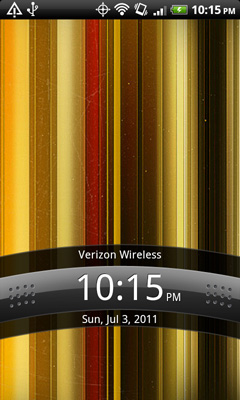 |
 |
The other Sense customizations are pretty standard. There's widespread integration of Facebook if you provide the Incredible 2 with your login information. The level of integration ranges from cool (automatically populating your address book with Facebook contacts) to frustrating (not delivering as good of a News Feed browsing experience as the dedicated Facebook app).
The UI in general is snappy and maintains a relatively high, but sub-60 fps frame rate. The apps launcher is split up into four screens: all apps, an automatically populated (and very useful) grid of frequent apps, downloaded apps and finally the Verizon preloaded apps.
Verizon puts a ton of preloaded apps on the Incredible 2, unfortunately you can't move them to the SD card or remove them entirely.
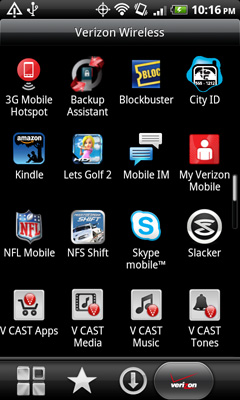 |
 |
HTC's web browser is pretty quick and provides relatively smooth scrolling - it's definitely not perfect but not frustrating either. Flash is supported and surprisingly enough it doesn't bog down the browsing experience all that much. Pages are loaded first, followed by flash elements. My biggest complaint about the browser is that tapping on the search/URL bar defaults to URL entry (as in you get a prefilled http://www.). I'm used to Chrome on the desktop which defaults to search instead.
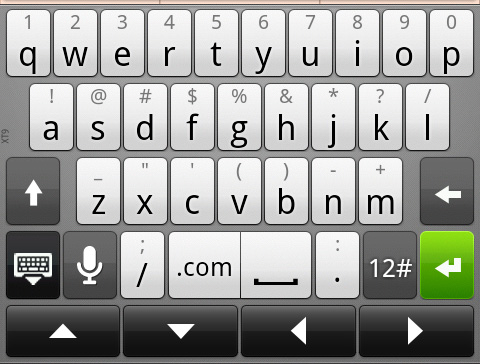
The last thing I'd like to comment on is HTC's Sense keyboard. I was pleased with it in the original Incredible and am still generally happy with it. It's still a bit busier than I'd like but it's functional, the keys are well spaced and I can type quickly on it.
Camera
The Incredible 2's camera app looks and works like it does on other HTC phones. I was surprised by how quickly the app can switch between shooting stills and video, it's virtually instantaneous. Switching between front and rear facing cameras is pretty quick, but it is a two-tap process: you have to first bring up the settings menu then select switch camera.
The rear facing camera has an 8MP sensor (the same s5K3h1gx sensor from the Sensation) augmented by two LEDs that act as a flash. Image quality is predictably...ok. If you're looking at web resolutions, the Droid Incredible 2 can put out some pretty nice looking images. However viewed at their native 3264 x 1952 resolution the captures range from disappointing to great. The rear sensor seems to have occasional problems with very sunny days. Low light photography is possible with incredibly bright LED flash however quality is still about average for a high end smartphone.
Capturing stills is thankfully pretty quick. The process takes about two seconds from screen tap to image capture.
Video quality is also middle of the road. You can shoot video at up to 1280 x 720 via the rear sensor:
Display
The Incredible 2's 800 x 480 display is decent by today's standards. Peak brightness is just under 350 nits, which is much better than the original Incredible and competitive with most modern Android smartphones:
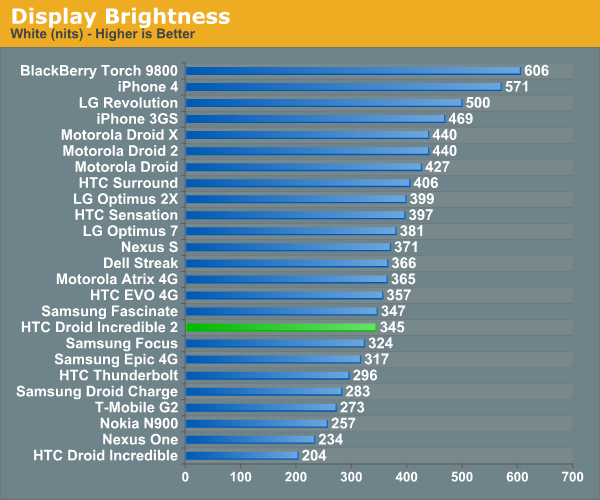
Black levels aren't bad either, but obviously not as good as the AMOLED enabled Android phones including the original Incredible:
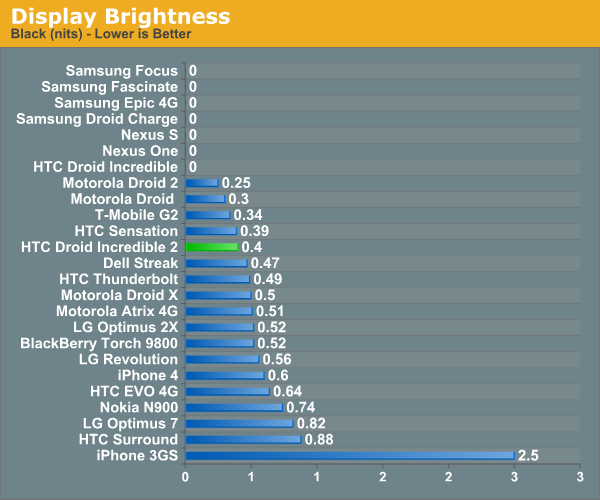
Contrast as a result is pretty competitive. You're not setting any records here but the display, along with the rest of the phone's hardware, is competitive:
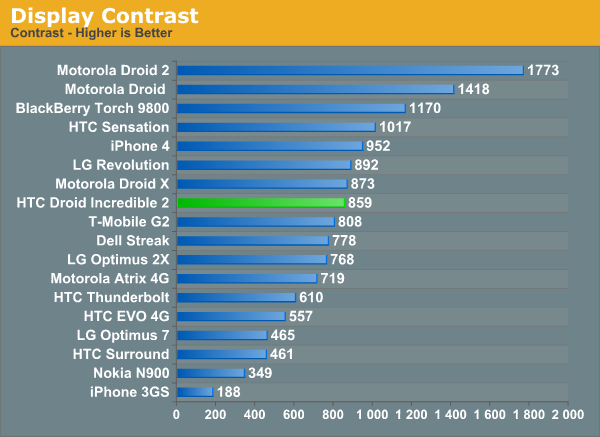
General Performance
In a world where dual-core smartphones are all the rage, the Incredible 2 actually performs surprisingly well. Actually using the phone is pretty quick. The UI is smoothly animated and although you can tell that you're not getting anywhere close to 60 fps (think 25 - 30 fps in most cases) the phone never feels slow. That's not to say that it feels fast, it just doesn't feel slow despite running last-year's hardware.
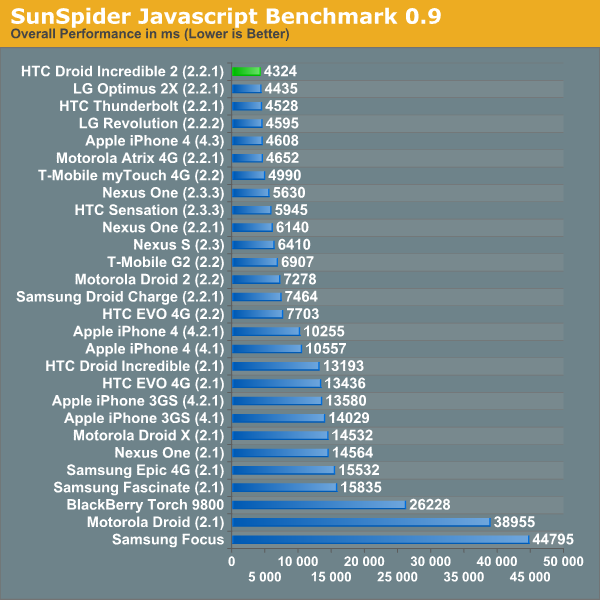
The benchmarks echo my user experience. In fact, our Sunspider results put the Incredible 2 at the top of the charts. Normal run to run variance makes the position of the top 10% of the phones insignificant, but the Incredible 2 runs through this javascript test very quickly.
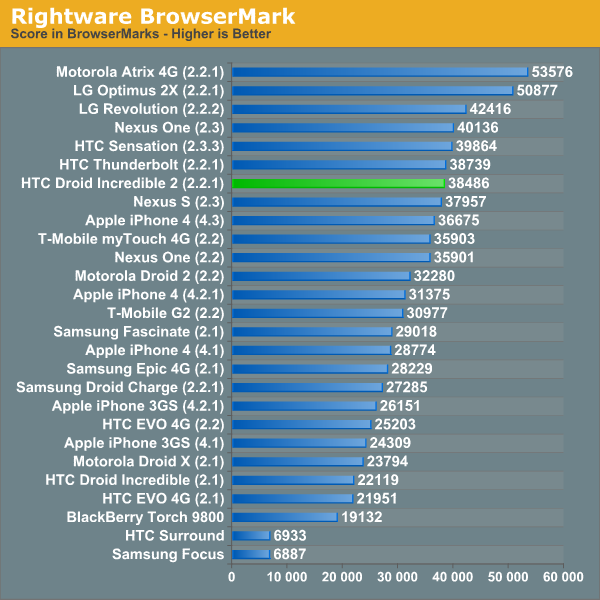
BrowserMark paints a slightly more realistic picture as the Incredible 2 is fast, but clearly behind the Tegra 2 phones.
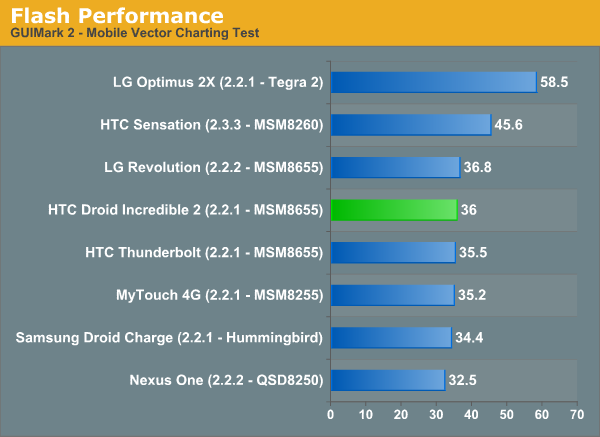
Flash performance is identical to other MSM8x55 phones. Only the newer MSM8260 and Tegra 2 based phones can deliver better performance here.
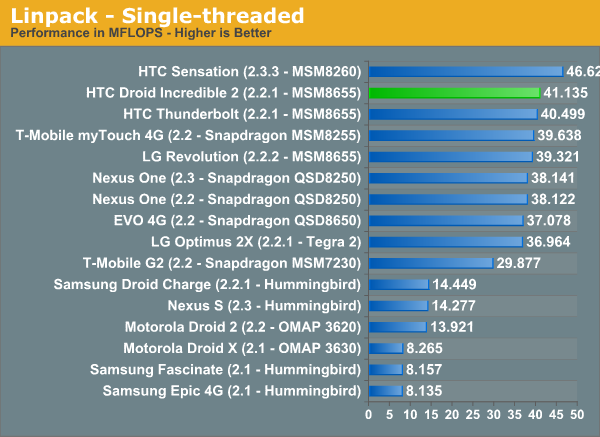
Testing Linpack under Android isn't super useful, it just shows us that single-threaded floating point performance hasn't really improved over the past year. Only the Sensation with its 1.2GHz clock speed gives us a real performance advantage here.
Its the Incredible 2's Adreno 205 GPU that shows its age the most in our performance tests:
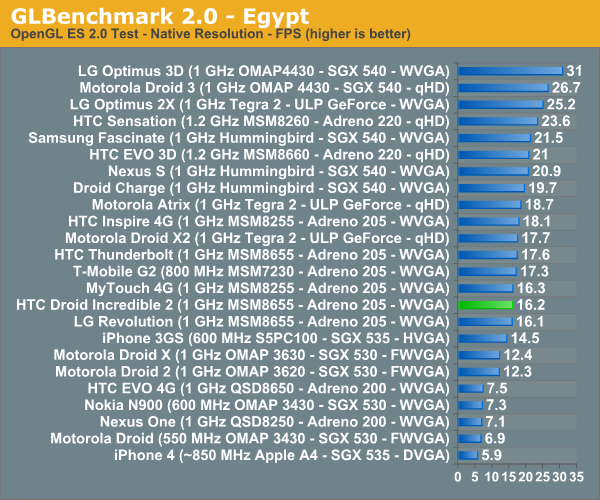
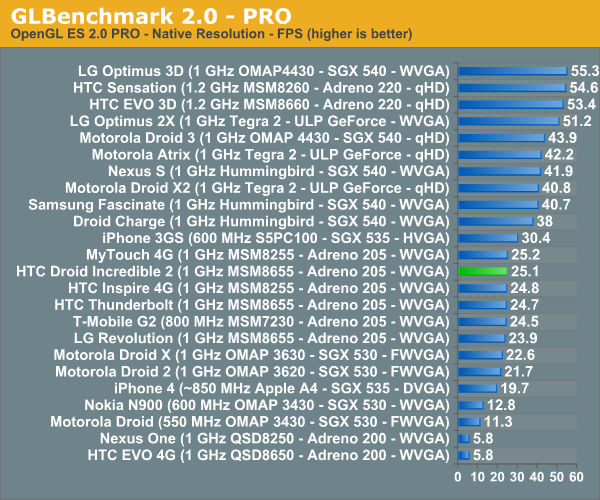
Imagination's SGX 540, NVIDIA's Tegra 2 and of course Qualcomm's own Adreno 220 are much better performers here.
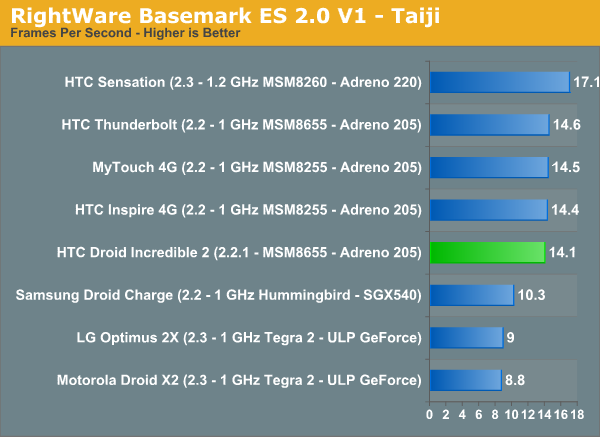
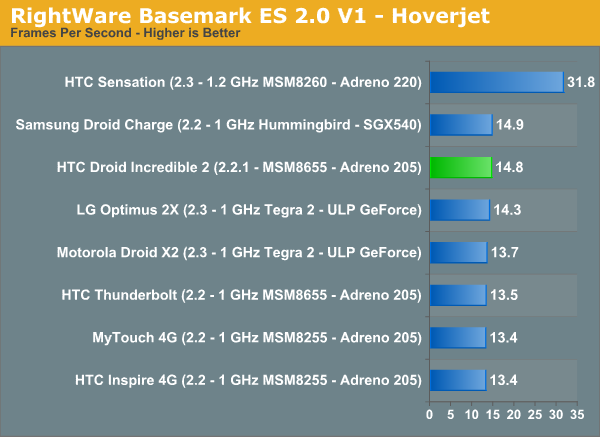
Network & WiFi Performance
The Incredible 2 comes with single stream 72Mbps 802.11n support. In our standard test however the best we ever saw was 16Mbps to the phone over WiFi (5 feet away from the AP):
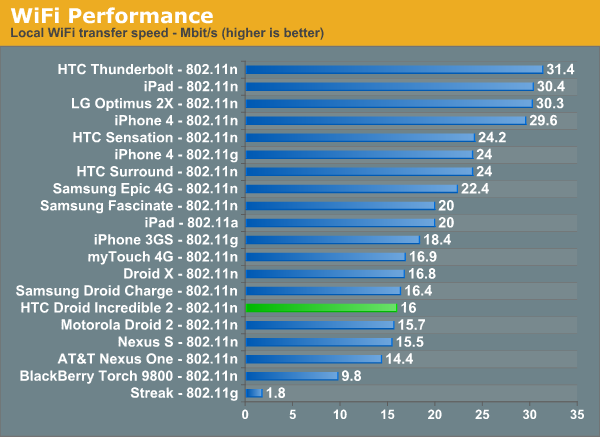
The Incredible 2 uses the same BCM4329 WiFi radio as the Sensation despite posting much lower performance.
I've never characterized Verizon's network performance in Raleigh before but it's generally pretty similar to other EVDO charts we've shown in the past:
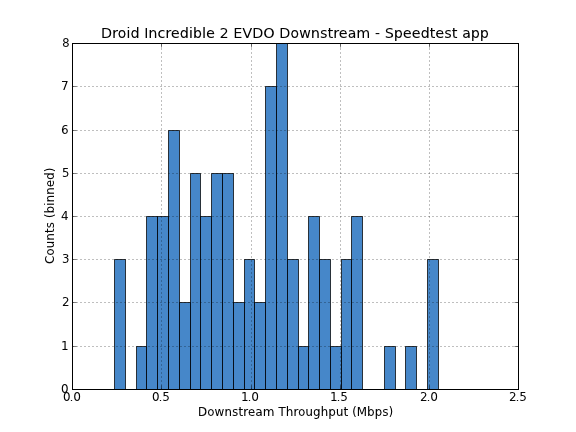
There's a lot of clustering around 0.5 - 0.8Mbps and then again around 1.2 - 1.3Mbps. I rarely saw speeds of 2Mbps around town, my experience with the Incredible 2 (and other Verizon phones) in Raleigh had downstream performance around 0.9Mbps.

Upstream performance varies a lot more. Often times I'd see great consistency with downstream speeds only to have completely unpredictable upstream performance. I don't believe this is an issue with the Incredible 2, just how Verizon behaves in Raleigh, NC.

Signal attentuation due to normal use isn't a problem with the Incredible 2. Like all other smartphones you do attenuate the cellular signal by just holding the phone but the drop is similar to other modern phones and obviously not as bad as the AT&T iPhone 4.
| Signal Attenuation Comparison in dB - Lower is Better | ||||||||
| Cupping Tightly | Holding Naturally | Holding in Case | On an Open Palm | |||||
| HTC Droid Incredible 2 | 14.0 | 12.0 | - | 0.0 | ||||
| HTC Sensation | 15.0 | 10.0 | 8.0 | 0.0 | ||||
| Samsung Droid Charge | 10.0 | 10.0 | 5.0 | 0.0 | ||||
| HTC Thunderbolt - LTE | 5.3 | 2.5 | - | 4.4 | ||||
| HTC THunderbolt - EVDO | 6.5 | 0.8 | - | 7.2 | ||||
| Verizon iPhone 4 | 16.5 | 15.5 | 9.0 | 7.9 | ||||
| LG Optimus 2X | 13.7 | 9.3 | - | 5.9 | ||||
| Nexus S | 13.3 | 6.1 | - | 4.3 | ||||
| Droid 2 | 11.5 | 5.1 | - | 4.5 | ||||
| BlackBerry Torch | 15.9 | 7.1 | - | 3.7 | ||||
| Dell Streak | 14.0 | 8.7 | - | 4.0 | ||||
| Droid X | 15.0 | 5.1 | - | 4.5 | ||||
| AT&T iPhone 4 | 24.6 | 19.8 | 7.2 | 9.2 | ||||
| iPhone 3GS | 14.3 | 1.9 | 3.2 | 0.2 | ||||
| HTC Nexus One | 17.7 | 10.7 | 7.7 | 6.7 | ||||
Battery Life
The Incredible 2's battery life is a mixed bag. Our 3G web browsing test paints the new Incredible as being decidedly middle-of-the-pack. At barely over 4 hours of continuous usage this is unfortunately average when it comes to modern Android smartphones. Some of the higher end Android phones like the Sensation and Atrix 4G are able to boast much better scores here but they are physically bigger.
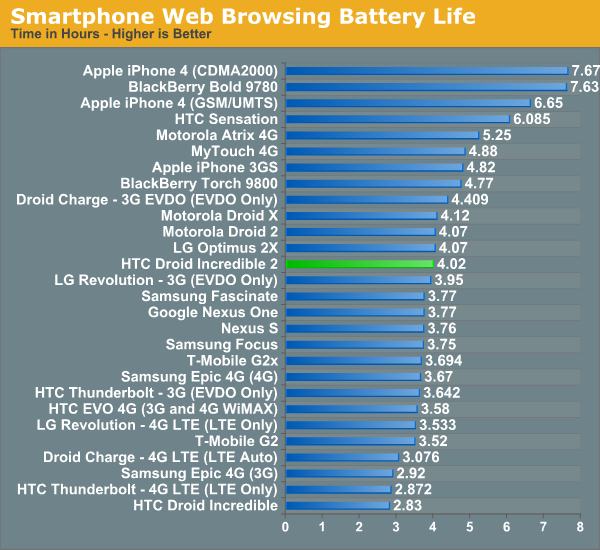
Our talk time test actually has the new Incredible doing worse than its predecessor, although obviously we're comparing results across vastly different versions of Android. If you're the type to talk on the phone for hours in a day, the Incredible 2 may not be for you.
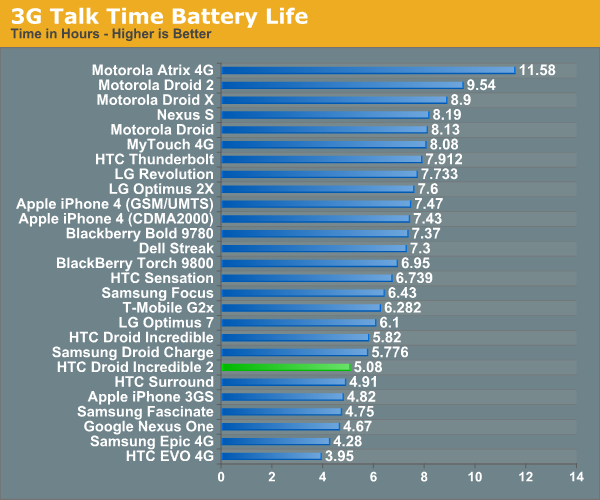
Turn off the 3G radio and transact data over WiFi and the Incredible 2 does much better. At 9.61 hours of continuous battery life the Incredible 2 is second only to Motorola's Atrix 4G in our tests, at least as far as Android phones are concerned. I have a number of friends that hardly use data on 3G because they're always using their phone at work over WiFi - they would be just fine with the Incredible 2.
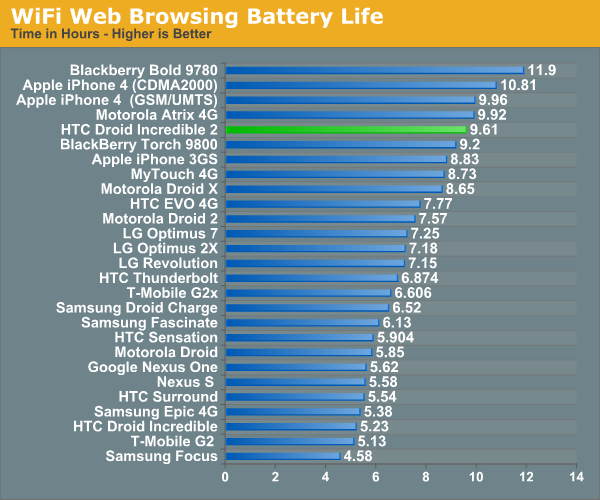
Final Words
Using the Incredible 2 brought back memories of the earlier phone that I was so fond of. It's still not perfect but a year's worth of evolution has resulted in a phone that's all around much better. The Incredible 2 is faster and generally has much better battery life than the original. If you own an Incredible and aren't in love with AMOLED, you'll appreciate the upgrade to the Incredible 2. The addition of world-mode support to the Incredible 2 does make it a unique option that will appeal to some business travelers.
In the continuum of Android smartphones, the Incredible 2 is nothing extraordinary. It is a good, well rounded phone that performs well but it doesn't win any awards beyond that. The lack of a dual-core SoC definitely doesn't hurt, but it's also something I don't like recommending if you're going to hold onto your phone for 1 - 2 years.
The fact of the matter is there aren't many dual-core smartphones available on Verizon today. In our upcoming Droid X2 review we look at one option but it's a much larger phone. If you're not ok with the Droid X2's 4.3-inch screen then the Incredible 2 definitely gets the job done, but if you're fine with a larger phone (and Motoblur) there's a better option out there on Verizon.

